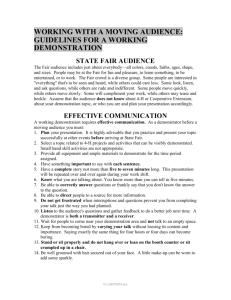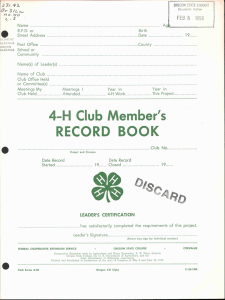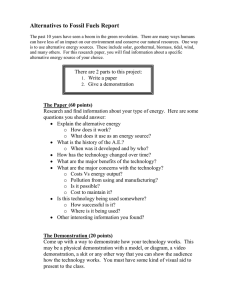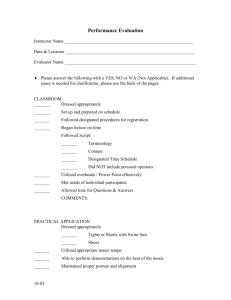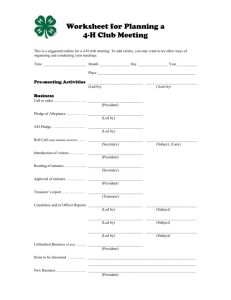demonstrate Th /r' 4-H Club
advertisement
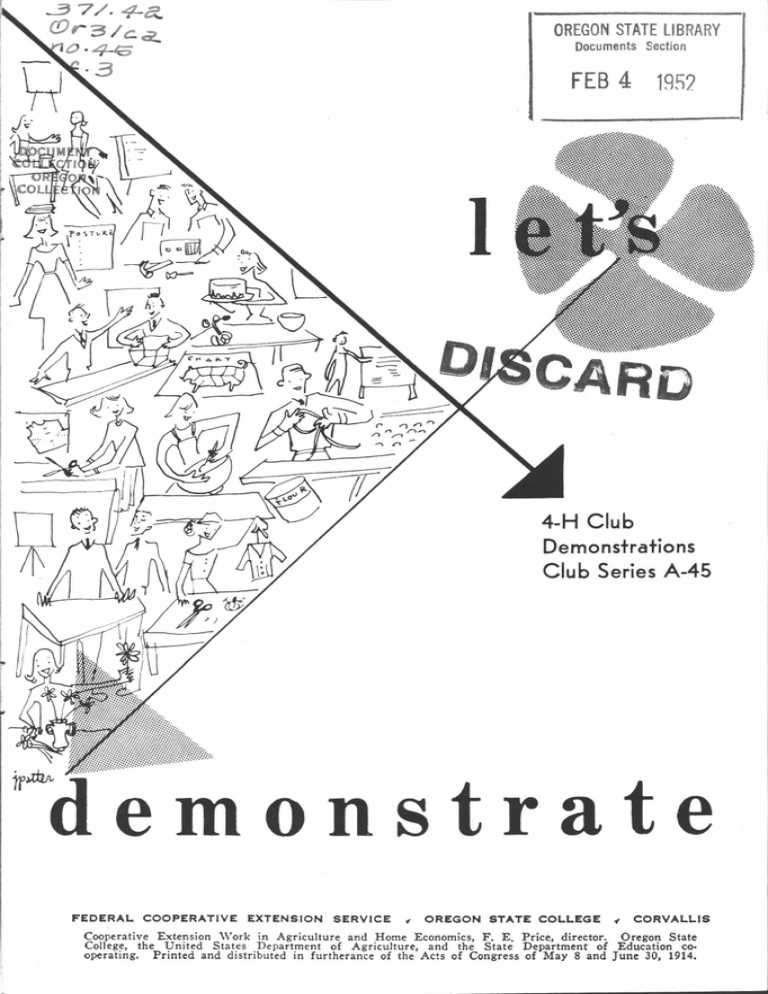
__3 7/. OREGON STATE LIBRARY Documents Section FEB 4 1952 Th /r' 4-H Club Demonstraf ions Club Series A-45 vIIl demonstrate FEDERAL COOPERATIVE EXTENSION SERVICE OREGON STATE COLLEGE Cooperative Extension Work in Agriculture and Home Economics, F. E. Price, director. College, operating. CORVALLIS Oregon State the United States Department of Agriculture, and the State Department of Education coPrinted and distributed in furtherance of the Acts of Congress of May 8 and June 30, 1914 ACKNOWLEDGMENT: Valuable suggestions were given by State and County Extension staff members. Art work by Jean Potter, former Umatilla County 4-H girl. ESTHER TASKERIJD State Extension Agent (4-H) ...._ - -- 4-H'ers--let's demonstrate! Let's learn how to give good demonstrations. It's simple. Two words tell the whole story"Show" and "Tell." You show how to do something and tell how to do it at the same time. If yours is an "up and coming" 4-H Club, each member will give at least one demonstration during the year. Why Demonstrate? By demonstrating you Learn by doing. Learn how to plan and work with others. Gain ability to "think, speak and do" in the presence of others. Have fun sharing what you've learned with other people. 4-H CLUB SERIES A-45 4 Team and IndMdual Demonstrations Both team and individual demonstrations have their place in our 4-H program. Team demonstrations are given by two club members. Each gives approximately half of the demonstration and assists his teammate for the other half of the time. Team demonstrations make, it possible to present more difficult subjects and help to develop ability to work together. Individual demonstrations are given by one Club mem- ber. They are very popular for local club meetings, community programs and may be entered in competition in some demonstration contests. The topic chosen must be a job that can be done by one person. What About Time? Some good demonstrations at local club meetings are 2 to 5 minutes in length. Team demonstrations usually will take 10 to 20 minutes. The important thing is to use the time necessary to do the job wellgive complete information and make each step clear. The maximum time allowed for contest demonstrations is 30 minutes. Choose Your Demonstration You can get off to a good start by choosing UtL/L. jMP/E Something you like to do. Something you've learned to do in your 4-H Club and practiced at home. One ideaone where actual processes can be shown. Something you think others would like to know how to do. -- LET'S DEMONSTRATE 5 Subject suited to the place where is to be given Some demon- it strations are good for small groups where everyone can gather close to the demonstrator but are not suitable for platform demonstrations Your first demonstration may be very simplehow to sew on a button, peel a potato, transplant a tomato plant, lead a calf, or saw a board. It may be a demonstration that the leader gave at the last meeting and you have been practicing at home. These simple demonstrations are stepping stones. You and your leader can choose the one that fits your present ability and experiencenot too easy or too hardso you will enjoy Il':;'. working with it. Each of your project bulletins has a list of suggested demonstration topics which may help you in making your selection. Plan What You're Going to Do Good demonstrations don't just happen. You need a well-organized plan. Your leader and other Club members can give you helpful suggestions. 1. List the steps or processes you want to discuss and demonstrate. 2. Arrange in order as they would naturally be done. 3. Develop in your own words an explanation of each step what you are doing and why you are doing it. You must imagine that your audience has never seen this process before, so include all important details, Of course, you won't say it the same way every time. 4. List all necessary supplies and equipment. 5. Plan posters or charts, if needed, to make important parts clear. 4-H CLUB SERIES A-45 6 G'afher Information After your demonstration is planned, look for all of the up-todate, reliable information you can find on the topic. All of your statements must be accurate. You should be able to quote the source for important statements. You need to know more than you tell. Possible sources of information are 4-H bulletins, Oregon State College publications, U. S. Department of Agriculture bulletins, books, magazines, experiences of others. Choose Equipment Wisely Remember that list of supplies and equipment you made when you were planning your demonstration? Check / it before presenting your demonstra" tion to be sure you have everything .. you'll need. Don't trust your memory or depend on your leader or parent. It's your demonstration! 4 . Use the type or kind of equipment which fits your demonstra- tion and makes it easy for the audience to see what you are doing. Use equipment which is available in your community, if possible. Have enough to do your work well, yet avoid the disorder which comes from having too much. Have equipment as uni- form as possible. It should be practical not showy or elaborate. Supplies should be placed attractive containers and labeled. Have containers large enough so you can measure without in spilling. LET'S DEMONSTRATE 7 Commercial names on equipment, boxes, or containers that are large enough to be seen by the audience should be covered. In 4-H demonstrations, we do not recommend or show preference for any one brand. Your demonstration set-up is important. Two tables are desirable for most demonstrationsa front table (the work table) and a back table (the supply table). For an individual demonstration, the supply table is placed to the left side of the front table (forms an "L") so the demonstrator will never have to turn her back to the audience. Using a slanted, raised platform on your work table or placing the back legs on blocks gives the audience a better view of many processes demonstrated. Trays or cookie sheets are useful in bringing supplies and equipment from the supply table to the front table. It's also helpful to have a tray on which to place used egg beaters, spoons, paint brushes, etc. A large mirror often is useful in showing certain steps and in displaying the finished product. An outdoor setting is often necessary for many agricultural and camp cookery demonstrations. Emphasize Main Points with Posters and Charts Posters and charts help to make clear important steps and processes in your demonstration. A poster or chart is good when it Has one main idea. Tells the story at a glance. Is large enough to be seen the length of the room (about 30 feet). Is readablesimlarge, well- ple, spaced letters with good margins. Is neat and clean. 8 4-H CLUB SERIES A-45 For local club meetings, make posters on wrapping paper using a dark crayon for the printing or writing. Display posters well. Show only one poster or chart at a time, and only for the time needed to explain that part. One giving a recipe or steps in a process should be left up during the demonstration of that process. Use an easel or board rack supported on a standard or a pasteboard standard placed on the table to display posters. If neither is available, your teammate may hold each chart while you explain it. Parts of a Demonstration A well-organized demonstration has three divisions, whether given by a team or an individual. 1. Introduction. 2. "Do" part (usually divided into two parts for team demonstrations). 3. Summary and questions. Introduction This is your "interest getter"make it original, short, and If you're demonstrating in public, you will want to tell: Who you are"I'm Doris Jones and this is my teammate, Jane Stearns." (A "natural" smile from Jane pleases the snappy. audience.) 4- Something about yourselvesthe name of your club and community, how long you've been in Club work, etc. You may give your leader's name, too. LET'S DEMONSTRATE The title of your demonstration and why you chose it. to show your listeners why it's important to them. 9 Try What you're going to dowhat they can look forward to seeing. One member of the team (Demonstrator A) tells all of this, and then brings in the other member (Demonstrator B) in a natural way, like this: "Jane will show you how to give your shoes a good shine." The "do" part This part of the demonstration develops the main idea you're trying to put across. Tell what to do, how to do it and why you do it. Show each step so all can see. Explain what you're doing so all can hear. When the action takes more time than the explanation, bring in some interesting sidelights related to what you're doing. Here's where you can use some of the material you read on the subject. You may quote what an authority has to say, tell about some of the equipment you're using or experiences members of your club and community have had using this practice. You don't have to talk all the timeshort pauses are good when there is something interesting to watch, but you'll lose the attention of the audience with periods of silence. Demonstrator B does the first half of the work assisted by Demonstrator A. For the second part, -.' they shift at a logical place and A becomes the demonstrator, assisted by B. He completes the lasi half of the job. Some teams like to make more than these two cFlanges, but too many shifts make your . ..- ..;; demonstration hard to follow. Summary Demonstrator B takes over. The summary is briefit gives your demonstration a finishing touch. Add no new information. Give a "crystal clear" picture of the two or three important points for the audience to keep in mind when they're trying to repeat the practice demonstrated. Charts or posters often help to stamp these 4-H 10 CLUB SERIES A-45 points on the minds of listeners. Display the finished product so it can be seen by the entire groupthen they'll know what results to expect. A tilted mirror helps to show products that cannot be held up. For some demonstrations, you will need to bring a finished product from home because the one you make may not be completed in time for the summary. While you're giving the summary, your teammate will prepare the finished product for display. He clears the table of all but the finished product and things needed for the summary. Questions When the summary is finished, give the audience an opportunity to ask questions. "Are there any questions ?" or "We shall be glad to tr) to answer any questions." Your teammate comes to the front table just before this closing remark so each of you can answer your share of ques. ,,, tions. Be sure the entire group knows the question you are answering. Sometimes you may need to repeat it so all can hear. In doing so, vary the form by saying, "The question is . . . "In reply to the question . . . ," or imply the question in the answer: "Never replace fuses without first pulling the switch." Questions and answers help to clear up any points not fully understood by your audience. They help round out the demonstration. If neither of you knows the answer to the question, you may say: "We're sorry, but we can't answer that question. Perhaps your county extension agent can help you, or you might write to Oregon State College in Corvallis," or give some other reference. When no more questions are being asked, close your demonstra- tion with a remark like, "If there are no more questions, we want you to know how much we've appreciated your interest in our demonstration, and we hope you'll go home and try our method of caring for shoes." You may wish to invite the audience to inspect or sample your finished product if it will not disturb the remainder of the program. Finally, pack your things quickly and make way for the next team. 11 LET'S DEMONSTRATE Team Demonstrations Two methods for giving team demonstrations are used in OreYou may choose the one which seems suited to your demonstration. Here is an outline for division of work in the demonstration method where each team member explains what he's doing as he does it: gon. Demonstrator A 1. Introduction. Demonstrator A talks. Give title of demonstration and introduce team. Why did you select this subject? How is it related to your club work? What are you going to do in your demonstration? Announce the next step in a very natural way: "Ruth (or Jack) will show you how to remove the old varnish." Demonstrator A assists. Help Demonstrator B by quietly bringing supplies when needed and removing equipment that has been used. Place supplies at side of front table. Remove ones no longer needed and place on supply table. Assist with demonstration work at front table when needed. When not busy, look on in interested manner. Be at front table before it is time to Demonstrator B Demonstrator B assists. Be at front table to be introduced. Then work quietly in the background. Assemble material (trays are useful). Make any advance preparation needed for next step, things not necessary for the audience to see. Help Dem- onstrator A when needed, arranging posters to be shown, etc. Be at front table an instant before close of introduction. 2. The "Do" Part (1st half). Demonstrator B talks and works. The real demonstrating begins here and is completed in the second part by Demonstrator A. Show and explain each step in the process. Have nothing in front of your work space so audience can see clearly. Arrange on smoothly. equipment and supplies at the sides. Shift demonstrators naturally and at a logical time: "Mary (or Dick) will show you how to give the table a lovely finish." 3. The "Do" Part (2nd half). Demonstrator B assists. change, so demonstration will move Demonstrator A talks and works. Give second half of process, explaining as you work. Help Demonstrator A. Be "on your toes," to see how you can be helpful. Make teamwork efficient and well-timed. Be at front table in time to begin the summary. Demonstrator A assists. Help with charts and posters. Prepare finished products for display. Clear front table of all but finished product and things needed for summary. Quietly gather all supplies and equipment in neat order, ready to leave. Be at front table before close of summary to answer your share of questions. 4. Summary. Demonstrator B talking and showing. What main points do you want the audience to remember? How may the results of your demonstration be of value to the audi- encecharts and posters help here. Attractively display finished products. No new information is given. Ask for questions. Thank audience and invite them to inspect results. 4-H 12 CLUB SERIES A-45 Here is the outline for division of work in the demonstration method where one member works while his teammate explains each step: Demonstrator B Demonstrator A 1. Introduction. Demonstrator A talks. Give title of demonstration and introduce team. Why did you select this subject? How is it related to your club work? What are you going to do in your demonstration? Announce the next step in a natural way: "Ruth (or Jack) will show you how to remove the old varnish." Demonstrator A works The real demonstrating begins here and is completed in the second part by Demonstrator B. Show each step Have nothing in front of your work space so audience can see clearly. Arrange equipment and supplies at sides. Shift demonstrators naturally and at a logical time: "Mary (or Dick) will show in the process. Demonstrator B works. Be at front table to be introduced. Then work quietly in the background; assemble material (trays are useful). Make any advance preparation needed for next stepthings not necessary for the audience to see. Help Demonstrator A when needed, arranging posters to be shown, etc. Be at front table an instant before close of introduction. 2. The "Do" Part (1st half). Demonstrator B talks. Explains each step as Demonstrator A shows the process. Assist with the demonstration work when needed. you how to give the table a lovely finish." 3. The "Do" Part (2nd half). Demonstrator A talks. Describe what Demonstrator B is doing as he does it. Assist with the process where it is possible. Demonstrator A showing. Show charts and posters. Give second half of the process. 4. Summary. Demonstrator B Attrac- tively display the finished product. Help in answering questions, Demonstrator B works. talks. Give the audience the points you want them to remember. Point out how results may be of value to them. Ask for questions. Thank audience and invite them to inspect results. Short team demonstrations may be divided into only two parts the first person giving the introduction and first half of the work, and the other member the second half of the work and the summary. LET'S DEMONSTRATE 13 Individual Demonstrations In an individual demonstration you have no teammate to help you. You work and tell about what you're doing as you do it. Your demonstration follows the same outline as a team uses. Move from one part into the next in a natural manner. 1. Introduction Tell who you are, something about yourself and your club (unless demonstrating at local club meeting). Give title of demonstration, why you chose it, and how it is related to your club work. Tell what you are going to do. 2. "Do" part Show each step in the process you're demonstrating. Explain what you're doing as you do it. Time the action and explanation so they fit together smoothly. Have a table for supplies and equipment joining the work table at your left, so your work table can be kept orderly. 3. Summary Give main points you want audience to remember. Attractively display finished product. Ask for questions. Thank audience and invite them to inspect or sample finished product. 4-H 14 CLUB SERIES A-45 Sell Yourself and Your Demonsfrafion Be natural and at ease. Smile now and then Call your teammate by name (John, Ruth) rather than "my partner" or "my teammate," etc. Show enthusiasmit's catching. If you're enjoying what you're doing, the audience will too. Have a catchy but fitting title. "Talk" your demonstrationmemorizing makes it sound like a recording and it doesn't sound sincere and convincing. It's also hard to make changes to fit the occasion. Look at the audience as much as possible. Talk directly to themnot to the table or to each other. Speak in complete sentences using good English and proflouncing words correctly. Avoid using "And-a" and overuse of "I" and "now." Be sure you can be heard, speak distinctly and not too fast. A pleasing voice and friendly man- ner make the audience want to listen Remember, if you raise your voice at the end of each statement you 11 never convince anyone that you believe what you re saving - Never turn your back to the audience while you're demonstrating. Your teammate brings all things needed, watches products cooking, etc. If he fails to remember, ask for what you need. Do not whisper. Watch your posturestand and move like a real 4-H'er. Be well groomedhair combed, clean clothes, shoes and hands. Put your mind at ease regarding your appearance before you begin your demonstration so that you do not need to be at all conscious of yourself. (For Foods Demonstra- tions hold your hair in place by wearing a net, ribbon, or band.) Wear neat, well-pressed costumes that are teamlike in appear- LET'S DEMONSTRATE 15 ance and suited for the job you have to do. Girls should avoid jewhair ornaments, bright nail polish, etc. elry, Practice, and practice some more so that you have your information well in hand, can work smoothly, handle your equipment easily and have your demonstration "snap along" without giving the appearance of being hurried. Notes are not used in contest demonstrations. Be neat and efficient in your work habits. Use accurate measurements; start and finish with a clean work table; avoid placing anything in front of your work space, so those watching can see all steps clearly. Don't reach in front of your teammate; don't be wasteful. Be willing to take suggestions and profit by them. Accidents happen to everyone, so don't let a mishap upset you. Explain what happened, if it seems necessary, and then go right on with your demonstration. Demonsf rate First in Local Clubs In 4-H Club work we give demonstrations for local club meetings, community groups, and competition at county and state events. Early in the club year, make plans to include both individual and team demonstrations in your club meetings. When the programplanning committee has listed the demonstrations that seem to meet the needs and interests of your group, each of you can have an opportunity to select the one or ones you'd like to work on. Then the committee can schedule them when they are most timely. These demonstrations given at local club meetings are generally simple. They may be developed further and "polished" for public presentation. Take advantage of every opportunity to present your demonstrationdeveloping it took time for study, preparation of illustrative material, and practice. The more times you give your demonstration, the easier it will be to do it and the better you'll be able to give it. 4-H 16 CLUB SERIES A-45 Your 4-H demonstration can be given in many places: At home Local 4-H meetings County Leader Association meetings Home Extension Units Community club meetings P.T.A. meetings School groups Women's clubs Local stores (during National 4-H Weeks) Grange, Farm Bureau and Farmer's Union meetings Ladies' Aid Crop and Livestock Improvement Association meetings Soil Conservation meetings Club tours Fairs, and local and county 4-H shows Demonsfration Confesfs Each 4-H Club should be represented at the county show by one or more demonstrations. It's a good chance to share what they've learned with more people, and compare skills with that of other boys and girls from all over the county. They'll make some new friends, too. If you are chosen to represent your club, your demonstration is considered a product of the club and all members may help with it. They might make posters or illustrative material, or help find information. By sharing in the preparation, younger club members especially gain a better idea of how demonstrations are done. Remember these details when you are participating in a contest: Locate the place where the contest is being held as soon as you arrive. Check the exact time you are to be on the program. Be promptbe ready 15 to 30 minutes ahead of schedule. Check the equipment provided (stove, etc.). Be sure that you know how to operate it or know who is in charge to help you. Have your materials arranged so that you can set up your demonstration quickly and without assistance from your leader or parents. After the demonstration, move your things from the platform immediately. Leave the tables or area neat and clean. Pack your equipment at once so there will be space in the preparation room for other teams. Do this quietly, so you won't disturb the team that is demonstrating. Remember, in any contest, that you have gained personally if you did the best you were capable of doing regardless of the color of ribbon you were awarded. Keep trying! 17 LET'S DEMONSTRATE When you are in a contest, make an effort to discuss your demonstration with the judge to learn your strong points and where you can improve. The following score card is used in judging contest demonstrations. Use it at club meetings as well as in contests to see how your demonstrations rate. OREGON SCORE CARD FOR 4-H TEAM AND INDIVIDUAL DEMONSTRATIONS Rating (check proper column) Excellent Points to check Good Fair Poor Demonstration set-up Arranged by demonstrators _______ ______ _______ _______ Well-organized ------------------------------------ - _________ -________________ -_______ Appearance of demonstrators Suitably dressed _______ ______- _______ ______ Neat and clean Goodposture ----------------------------------- - ---------------------------------------- - Introduction *Audience attention gained ------------- - _______ ______________ _______ _______ _______ _______ _______ _______ Reasons for choice of subject ---------- - _______ Outline of demonstration Presentation *Deliyery natural and distinct Manner pleasant and businesslike Skill in workmanship Illustrative material Materials kept orderly All work visible to audience Steps made clear Audience attention held Team work tEqual division fEffective cooperation Subject matter ------------------ - _______ _______ ________ ________ _______________________ _______ _______ - --------------------------- - _______ __________ ---------------------- - ---------------------------------- - ________ __________ __________ _______ ________ _______ _______ _______ _______ _______ ---------------------- - -______ ---------------------- Oneidea *Usable for home or farm _______ ------------------------------------------------ Related to club experience *Actual processes demonstrated Accurate information Complete information -------------- - ________________ ________________ ________ ______ ________ -_______ ________ ------ - -_______ -------------------------- _____ ________ ______ Logical sequence ---------------------------------Summary------------------------------------------------ *Answers to judge's questions Results *Actual product shown Quality of finished products Demonstration area left neat -------- - ---------- ________ ________ ______ ________ ---------- * Items to be given special consideration in close decisions. t Individual demonstrators are not required to have a rating on these items. Health demonstrators are not required to have a rating on these items. A good goalEvery 4-H member take part in at least one demonstration this year.
